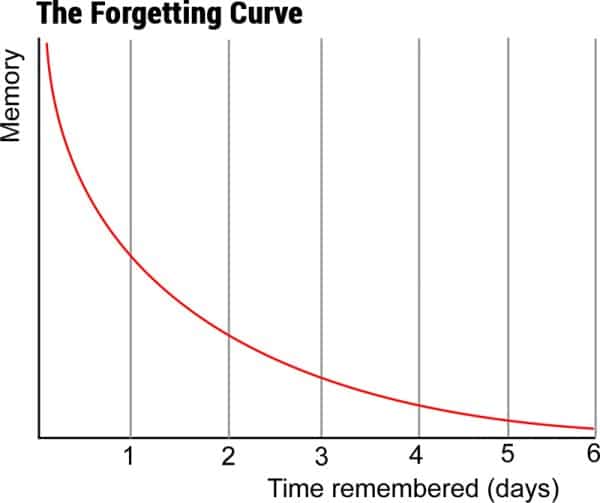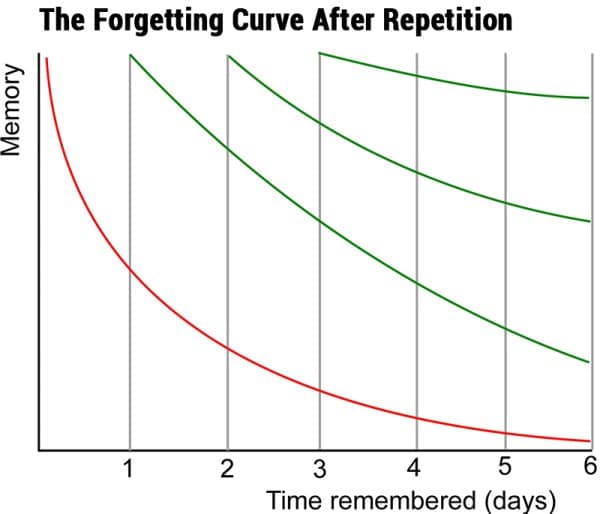How would you like to remember nearly everything you’ve ever been taught?
German psychologist Hermann Ebbinghaus had a theory about this. He conducted some interesting research to find out how long we retain newly acquired information.

A representation of the forgetting curve showing retained information halving after each day.
The “Ebbinghaus Forgetting Curve” is shocking: we tend to forget 50% of all new information within one day and 90% within a week. We all intuitively know this, but it’s alarming when we’re confronted with the research, the reality, and the speed and depth of this phenomenon.
So how does this exponential memory loss impact the $70 billion per year sales training industry? Ebbinghaus would tell us that most of our training is quickly forgotten, never applied and never placed “in service.”
Is it 50% forgotten? Is it 90%? Even if he’s half right, it looks like we’re paying a heavy price for sales training that rarely works, adding up to billions of wasted training dollars.
As a former consumer of traditional sales training during my years as a radio executive, my team and I thought we were doing the right thing. We hired competent sales trainers and consultants. Their material was solid. Our team was receptive. But rarely did we see a sales improvement commensurate with our investment of time and money. What were we doing wrong? We didn’t fully understand the forgetting curve. An expensive lesson, but a lesson well learned.
FIVE WAYS TO COMBAT THE SALES TRAINING FORGETTING CURVE

Forgetting Curve showing improvements in retention after 1, 2, and 3 repetitions.
Thankfully, Ebbinghaus also gave us some prescriptions. He found that retention levels can be improved with spaced repetition. By designing training programs that our people will love, remember, practice and apply we can beat the curve and have a good shot at improving performance.
- Reinforce: Training simply leaks out unless it’s reinforced. Every time we reinforce training, the rate of memory decline decreases. The best idea is to reinforce within a few days of the training event. Staging frequent practice sessions and interactive review events such as role playing and scenario training will help solidify and install the new information.
- Real-world: Use role plays and scenarios built around actual sales situations. The more relevant the training is to real world selling situations, the more memorable and actionable it will be.
- Interactive: The days of relying solely on lecture-only, one-off sales training events are gone. The best training programs are highly interactive. Discussions, debates, role-plays, scenarios, practices, rehearsals and modeling all help.
- Relevant: Weak and irrelevant material is quickly forgotten. One and done sales training doesn’t work today. The best sales training programs are customized to fit your business and your sales team. This ensures that the training is on point and relevant.
- Simple: The way material is presented is key. Many trainers use the “firehose” method, a torrent of material that not even a genius could remember. Rather than spending time trying to decode the training, making it focused and simple helps improve retention.
HOW MUCH MONEY ARE YOU LEAVING ON THE TABLE?
As a small business owner, your sales training may be a double-barreled problem and may be costing you twice: First Problem: a large portion of your training dollars are probably being wasted because the material is quickly forgotten and never applied. Second Problem: the hoped-for sales improvement that the training was supposed to deliver never happens. Your sales team is still leaving money on the table. A double cost.
FIGHTING THE FORGETTING CURVE—ACTION STEPS
- Reject any sales training that doesn’t offer built-in antidotes for the forgetting curve. Built-in reinforcement, accountability, and monitoring the use and full assimilation into your sales process. Any program that doesn’t account for the installation of the training will fall way short of your expectations.
- Audit your current training program. Is it designed so that the material will be retained and used? How many times per week does your team practice? Is this purposeful practice, deliberate practice, evaluated and critiqued by a management level person and/or a qualified sales trainer? Everyone needs a coach. Remember, only perfect practice makes perfect.
- Get in touch with the Wizard of Ads Employee Optimization and Sales Rx group. We’ll help you understand where your training is now and show you how to conduct sales training that produces results. Our superpower is fighting and overcoming the effects of the Sales Training Forgetting Curve.
- Sales Process Fail:How Many Dollars Are You Leaving On The Table? - April 24, 2023
- How To Get The Most Value From Your Sales Training - March 31, 2023
- Leadership and the Little Voices - April 12, 2022
